Genre: Action Developer: Wolf Team Publisher: Renovation Players: 1 Released: 1990
From about 1987 to roughly 1995, a small group of programmers in Japan named Wolf Team were rather prolific game makers. It seemed like every time you turned around, they’d pumped out another shmup, action RPG, FMV, pinball, traditional RPG or action game for one system or another. Though a sizable number of their games didn’t make it to US shores, Wolf Team’s Final Zone did indeed cross the pond in 1990. A mech-like action game, it tried to keep players on the edge of their seat with its action and gameplay. Did it succeed, or did the game simply make players get up walk away? Read on.
It’s one hundred years in the future. Wars as mankind knows them are a thing of the past. With all mass destruction weapons banned, conflicts are now fought with New Age Power-Suits (NAPs), large, mechanized body armors that are worn into battle. As the best solider of El Shiria Military Nation, you, Howie Bowie, get an urgent call to occupy and destroy Point A-46K Bloody Axis. Suicide mission? Perhaps. But it’s what’s been entrusted to you. Now it’s time for you to use all your strategies and weapon skills to take the Final Zone.
If there’s one thing Wolf Team was good at, it was making graphics. The visuals of [i]Final Zone[/i] reflect this in that they’re pretty nice. Everything’s drawn in a ¾ isometric view, with plenty of little details, touches and shading on your surroundings, battle suit, the small enemies and of course, the bosses. While the designs of those enemies are a bit simple at times, they’re not horrid. Little tanks, helicopters, robotic spiders… they all look fine, just not particularly impressive. The backgrounds, on the other hand, turned out a bit better than the characters. While the battlefields are static for the most part, and they’re really not very large (they do loop though), there are all kinds of little details and highlight/shadow work on everything. Whether it’s a military base, a ruined city, or out in the semi-open countryside, there’s a fair amount of variety overall, which helps to offset the more repetitive nature of the enemies. So, while it’s not Wolf Team’s best effort in terms of graphics and designs, it does still pack a fair visual punch.
In the aural department, the game fares about the same as the graphics. There are sound effects to go with your various weapons, explosions and such, and they all sound OK. However, they’re always competing with each other. One sound effect cuts off another, then that one’s cut off by the first before something else comes along to cut it off again. The result is a lot of effects that don’t get fully played half the time, which can get distracting. When it comes to music, this game’s more good than bad. While half the songs are enjoyable (especially “Army’s Song” and “After the War”), many of the rest feel average. Not grating or sub-par, just not very memorable. Three of these songs are used for a lot of the game, making for some unfortunate levels of musical repetition. And while most of the instruments are fine, what struck me about the songs is that they suffer from rather weak drums that feel more at home on the Master System or NES than the Genesis. It’s a shame, because the compositions around those weak drums would have benefited from having the drum samples Motoi Sakuraba used in his other efforts like Granada and Arcus Odyssey… games which quickly followed FZ in coming to the Genesis.
Regarding gameplay, Final Zone is rather well packed in several areas. There are seven stages to fight through, the first six of which consist of a battlefield and a boss. You have a set number of enemies to destroy on each stage before you can move on, and you’ve got twenty weapons to use against those enemies in the game (though really, a fair amount are just variations on the ‘bullet’ and ‘missile’-type guns). These weapons include things like a NAPALM gun, homing missiles and a straight up vulcan cannon, with each weapon having two functions… a primary usage, where the ammo is unlimited but it’s weaker, and a secondary usage, which has limited ammo but packs more of a punch. You can swap weapons at any time, and all of them can be used for a primary or secondary weapon. An interesting bit about this game regarding the weapons, is that the weapons in stock also represent your life meter. You have fourteen life bars, which means you can have fourteen weapons in stock. And when you’re hit, you lose a weapon/life bar (note: it takes the weapon that’s at the bottom of your stockpile, not the ones you have equipped unless you’re down to two bars of life). However, each stage has a handful of weapon pods that appear as you kill enemies, so you can replenish your life/weapons as you fight pretty easily.
The battle suit you pilot has two interesting control options in play. The first is that you can either walk at a normal speed, or you can double tap the d-pad and dash at a much faster pace, with the latter coming in handy for outrunning swarms of enemies and bullets. The other trait allows you to hold down the fire button and move around while continuing to fire in the same direction, making for some very useful strafing maneuvers during boss fights. Both of these things will come in handy as the game goes along, so their inclusion not only added a little more depth but gives you a better shot at success.
Now here’s where we look at what’s wrong. And unfortunately, there are indeed several substantial things to note. Perhaps the biggest complaint to be leveled against this game, is the playing speed. This game has a very inconsistent frame rate. It speeds up a lot when there are no enemies on the screen, and then crawls when there are a few enemies there firing at you. The game is quite literally in near constant speed fluctuation as you play, and that’s not good at all. Another big complaint is the way a good number of the enemies move. They don’t drift across the screen, they jump. This quirk is compounded when you encounter the plentiful and rather oddly sporadic slow down, making it look almost as if the enemies were moving from hexagon to hexagon in an old turn-based strategy game. Meanwhile, the bullets those enemies fire move more smoothly around, as do some of the bosses and the big tanks. It’s a visual anomaly that really should have been addressed and makes the game feel sloppy in this area.
To add to the main problems, we get to how readily you can become stuck on things at times. You’re trying to get away from a flock of homing mines, only to get stuck on a wall or object for a short time. This especially rears its ugly head on the more cluttered backgrounds, making for frustrating moments when you’re low on health and trying to duck behind a wall to save your hide. Yet another issue is that while the controls are all right when you’re moving at a normal pace, they fight you at times if you’re dashing. You can be moving fast up the screen, turn, and then be moving painfully slowly even though your battle suit is still animating like it did when you were moving fast. At these moments, you have to either let go of the d-pad just so you can get back to a normal walking pace again or wait for your battle suit to get moving faster on its own (which it won’t always do). This may be a penalty to changing directions too sharply, but it feels more like a coding oversight.
Now, when I say the controls are “all right, “I’m talking of course about the response time between you pressing the d-pad or button, and your character taking action. However, there’s a strange issue that crops up regularly. Your character visually turning doesn’t always coincide with its direction change. You’ll be going up not firing (or having just stopped firing), turn right and you’ll almost immediately move right. But your battle suit won’t visibly turn to its right for about a half second or so. Perhaps it’s for allowing you easier access to last minute strafing, but it also leads to you getting a delay in turning to face the enemies that are attacking you from that new direction. Thus, it’s not a feature, but a hindrance.
On the more minor side, there aren’t that many enemy types. You’ll see those jack-like shapes A LOT, and each time a new enemy appears, it’s reused pretty frequently on subsequent stages. It’s not tragic or anything, but a little more variety wouldn’t have hurt. One more area is how hard it can be at times to find that last enemy to either end the stage or bring about the next enemy wave. As mentioned, the stages aren’t that big, but the endless looping that each stage uses to make them seem bigger allows those little enemies to stay completely away from you at times, leading to unnecessarily long bouts of hunting.
So the big question is, is Final Zone worth a damn? Honestly, I can only say “sort of.” The graphics are descent, the music is more enjoyable than not, there are plenty of weapons to use, and the length of the game is just about right. The thing is, some of the awkward traits of the controls and getting stuck on things make the game unnaturally harder when things get hectic, the near constant fluctuation in playing speed is very annoying, and it’s really only those issues that make the game challenging. For an earlier Genesis game, it shows potential. But that potential is partly obscured by Wolf Team’s apparent lack of time spent working on it and/or their familiarity with the Genesis hardware. It still has redeemable qualities that can make it fun at times, but I can only call this game decent… not a must have.
SCORE: 6 out of 10

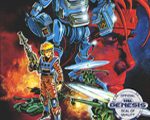
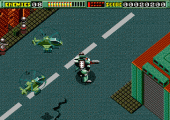
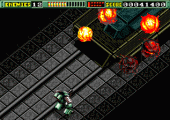
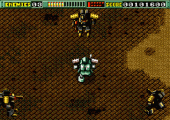
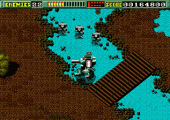
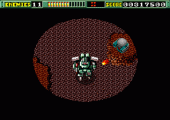
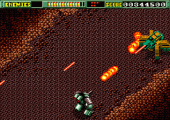
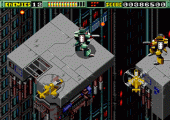
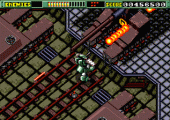
A strange game with interesting style and odd mechanics. The controls take some getting used to. I like it but I’m far too forgiving of games with giant mecha as the hero.